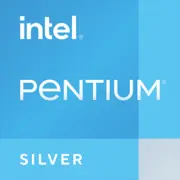Intel Pentium Silver N5000

Intel Pentium Silver N5000: A Budget Processor for Basic Tasks in 2025
Introduction
Even in 2025, budget laptops are still in demand, especially among students, office workers, and those in need of a "basic" device. The Intel Pentium Silver N5000, which was released back in 2017, continues to be utilized in ultra-budget devices. Despite its age, it remains present in the market. Let's explore who this chip is suitable for, its strengths and weaknesses, and whether it's worth considering in the era of energy-efficient ARM processors and hybrid architectures.
1. Architecture and Process Technology: Gemini Lake at 14 nm
Cores, Threads, and Frequencies
The Pentium Silver N5000 is built on the Gemini Lake architecture (14 nm), which evolved from Apollo Lake. This is a 4-core processor without Hyper-Threading support, resulting in 4 threads. The base frequency is 1.1 GHz, and the maximum turbo mode frequency is 2.7 GHz. It has a 4 MB L2 cache, while L3 cache is not present.
Integrated Graphics
The chip is equipped with Intel UHD Graphics 605 iGPU, which has 18 execution units and a frequency of up to 750 MHz. The graphics support 4K video decoding (H.265, VP9) but are not suitable for gaming.
Architecture Features
- Low power consumption due to passive cooling.
- Support for DDR4/LPDDR4 memory (up to 2400 MHz).
- Lacks support for AVX instructions, limiting performance in professional applications.
2. Power Consumption and TDP: 5 W for Silence
The processor's TDP is only 5 W, allowing it to be used in fanless devices. This is a key advantage for:
- Ultra-portable laptops (e.g., ASUS VivoBook L203NA).
- Mini PCs and tablets with passive cooling.
However, the low TDP has a downside: under prolonged loads (such as video rendering), the frequency drops to the base level (1.1 GHz), sharply reducing performance.
3. Performance: Modest Results
Office Tasks
- Document work (Word, Excel), web browsing (10+ tabs in Chrome) — comfortable.
- Running Zoom + browser + messaging apps — may experience slowdowns.
Multimedia
- Playback of 4K video (YouTube, local files) — smooth thanks to hardware decoding.
- Photo editing in Lightroom — slow, but it can handle occasional edits.
Gaming
- CS:GO at minimal settings (720p) — 25-30 FPS.
- Minecraft (without shaders) — up to 40 FPS.
- Modern AAA titles (2025) — not accessible.
Turbo Mode
Short bursts to 2.7 GHz help with brief tasks: opening heavy websites, PDF files. However, after 10-15 seconds, the frequency drops to 1.5-2 GHz.
4. Use Cases: Who is the N5000 Designed For?
- Students: Note-taking, online courses, Netflix.
- Office Workers: Documents, email, video calls.
- Elderly Users: Simplicity, long battery life.
- Home Media Centers: Streaming video via HDMI.
Not Suitable For:
- Gamers.
- Designers, programmers, video engineers.
5. Battery Life: Up to 12 Hours of Operation
With a battery capacity of 40-50 Wh, laptops with the N5000 manage 8-12 hours (web surfing, office tasks). This is supported by:
- Intel Speed Shift: Dynamic frequency management.
- C6/C7 core states: Disabling unused cores.
- Adaptive screen dimming.
Example: The Lenovo Ideapad Slim 3 with N5000 and a 45 Wh battery lasts 10 hours during reading mode.
6. Comparison with Competitors
AMD Athlon Silver 3050e (Zen, 6 W):
- Better performance in multi-threaded tasks (+15% in Geekbench 6 Multi).
- Support for faster memory (DDR4-2400).
- Laptop prices starting from $350.
Apple M1 (in MacBook Air 2020):
- Absolute leader in energy efficiency and speed.
- Laptops with M1 start from $700 — a different price segment.
Intel Celeron N5100 (Jasper Lake, 10 nm):
- 30% higher performance.
- Support for PCIe 3.0 and Wi-Fi 6.
- Devices start from $400.
Conclusion: N5000 remains relevant only in devices priced under $300.
7. Pros and Cons
Strengths:
- Low laptop prices ($250-400).
- Quiet operation (no fan).
- Long battery life.
Weaknesses:
- Weak performance in multitasking.
- No support for modern standards (USB4, Wi-Fi 6).
- Outdated 14 nm process technology.
8. Recommendations for Laptop Selection
Types of Devices:
- Ultrabooks: ASUS VivoBook L403.
- Convertibles: HP Pavilion x360.
- Budget Laptops: Acer Aspire 1.
What to Look For:
- Must-Have: SSD (256 GB), 8 GB RAM.
- Desirable: Full HD screen (not HD+).
- Additional: USB-C port for charging.
Price Examples (2025):
- Acer Aspire 1 (N5000, 8/256) — $299.
- Lenovo Ideapad Slim 3 (N5000, 4/128) — $279.
9. Final Conclusion
The Intel Pentium Silver N5000 is a processor for undemanding users. Its key advantages include:
- Extremely low price.
- Quiet operation and long battery life.
It is suitable for:
- Education and basic tasks.
- As a second laptop in the home.
- For those unwilling to pay for "extra" performance.
Do not consider it if you need: gaming, video editing, or work in AutoCAD. In 2025, there are newer options even among budget chips (such as Intel N100 or AMD Mendocino), but if the budget is strictly limited to $300 — the N5000 can still serve as a temporary solution.
Basic
CPU Specifications
Memory Specifications
GPU Specifications
Miscellaneous
Benchmarks
Compared to Other CPU
Share in social media
Or Link To Us
<a href="https://cputronic.com/en/cpu/intel-pentium-silver-n5000" target="_blank">Intel Pentium Silver N5000</a>